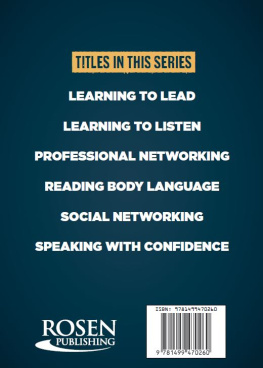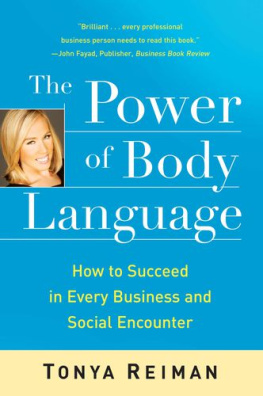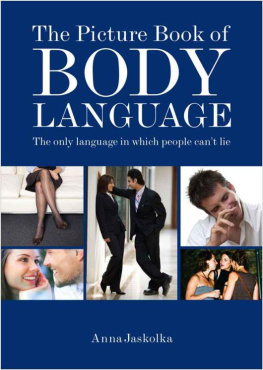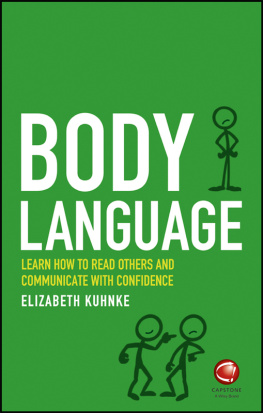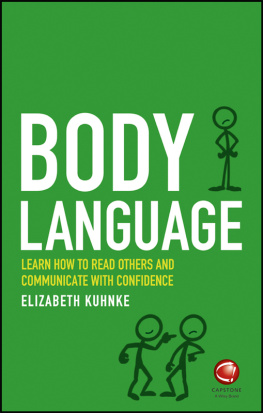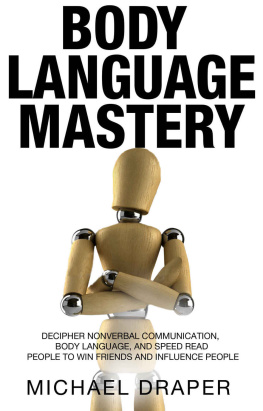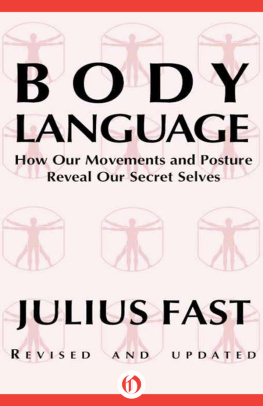- CHAPTER 1
BODY LANGUAGE BASICS - CHAPTER 2
EXAMINING FACIAL EXPRESSIONS - CHAPTER 3
A HANDY COMMUNICATIONTOOL - CHAPTER 4
PUTTING THE PIECES TOGETHER - CHAPTER 5
BODY LANGUAGE IN ACTION
S ome people have a way with words. They speak or write well, and some might think this alone makes them very effective communicatorspeople who can successfully share their thoughts, ideas, and feelings with others and understand the thoughts, ideas, and feelings of others in return. However, words are only one tool we use when we communicate.
Speakingalso known as verbal communi-cationis an important part of how we express ourselves and how others express themselves to us. For example, if you want to tell a potential boss in a job interview that they should hire you, you might say, I think Id be the perfect fit for this position. In a similar way, if you ask how a friend is doing and they say, Im doing great, youd most likely assume theyre having a good day.
Words dont always tell the whole story, though. If you tell a potential boss, I think Id be a perfect fit for this position, but you wont make eye contact with them and youre slouching in your chair, they might not believe your words. The same thing could happen if your friend tells you theyre doing great but theyre frowning and their body is turned away from you. Would you still think theyre having a good day?

Effective communicators know the words we use are only one of the many ways we communicate at home, at school, and at work.
Nonverbal communication, which is the way we express thoughts and feelings without words, can often tell us just as much asand sometimes more than verbal communication. One of the most important aspects of nonverbal communication is body language, or the ways we communicate through the movement of our body.
Without even knowing it, we communicate so much through our body language every day. When we slowly walk into the kitchen for breakfast without making eye contact with anyone else, were communicating that were tired and dont want to talk yet. When we move our hands a lot while telling a story, were communicating that were excited. Even the way we stand tells a story. Standing up tall and taking up space lets people know we feel confident, while slouching and looking down at our feet makes us look shy or sad.
Body language involves the facial expressions we make, the gestures we use, our posture, and much more. Each of those things plays an important part in the messages we send out to others and the messages they send out to us. However, its not always easy to interpret someone elses body language, and we sometimes communicate things with our own body language that we dont want to or dont mean to. This is why having a deep understanding of body language is such an important part of being an effective communicator. It allows us to examine our own behavior more closely so we can more clearly communicate exactly what we want to share with others. It also allows us to develop a stronger understanding of the people were communicating with and the things theyre saying without words.

Body language includes the position of our body when we speak and when we're listening. Leaning in shows we're paying attention.
Nonverbal communication has helped humans connect throughout history and across language barriers. Taking a closer look at what body language is and what it commonly communicates can help us strengthen our connections to others, avoid miscommunication and misunderstandings, and be sure others are seeing us exactly as we want to be seen.
CHAPTER 4
PUTTINGTHE PIECES TOGETHER
A persons body language involves their whole bodynot just their face and their hands. The arms, torso, legs, and even feet communicate important things about what were thinking and feeling. While the ways we use our face and hands are often the most obvious examples of body language, its important to take a closer look at the whole body because what someone is saying with their feet might be very different from what theyre trying to tell us with their face. By putting all the pieces together, we get the clearest picture of what people are communicating to us. Its also only when we fully understand how all the parts of our body work together to send messages that we can effectively communicate with others.

Body language is about so much more than just hand gestures and facial expressions. Its a head-to-toe form of communication!
Watch Your Tone!
Although we use our voice as part of verbal communication, many body language experts actually consider a persons voice to be part of nonverbal communication not the words it speaks, but the messages its tone conveys. For example, an unchanging tone is so boring that listeners tend to tune it out. A sarcastic tone can convey annoyance, while an excited tone can convey genuine enthusiasm.
The volume and speed of a persons speech can also convey information. If you speak too softly, you come across as weak, but if you speak too loudly, you appear aggressive. Practicing in front of someone you trust and getting their feedback can help you discover if you need to adjust the volume of your voice. In addition, many people talk faster when theyre very angry, nervous, or happy. They tend to talk slower when theyre frustrated, bored, or sad. To avoid speaking too fast or too slow, take care to insert short pauses after each phrase and longer pauses at the end of each sentence.
To be an effective speaker, also avoid the verbal pause, sometimes known as a verbal crutch. When you use a verbal pause, instead of injecting a brief silence after a phrase, you insert a stand-in word or noise, such as um, ah, like, or you know. Often, people dont even realize what they are saying or how often they use verbal pauses, but listeners notice. Overusing verbal pauses can make you sound less professional or credible.
To find out if you have a problem with verbal pauses, listen to videos or audio recordings of yourself talking. If you hear a string of ums and likes, start training yourself to replace them with brief, silent pauses. Its a challenging change to make, but it will help your overall effectiveness as a communicator in the long run.

Before you give a speech,record yourself whilepracticing it. This can helpyou notice verbal pauses.
UPPER BODY SIGNALS
We communicate a lot through the position of our arms and shoulders. For example, when we hunch our shoulders, we look like were trying to make ourselves smaller, which can sometimes convey a feeling of weakness or shyness. Another common shoulder movement is a shrug, in which the shoulders lift and the palms face upward. A shrug can show that you dont know whats going on or that you dont care.
Crossing your arms in front of your chest is another way to convey indifference through body language. By doing so, you make your arms a physical barrier between you and others. Crossed arms say that you are closed off and have little desire to communicate. The gesture is likely to make you seem unapproachable and unfriendly.

